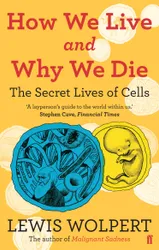This is a book all about cells, and makes the case that the cell is the fundamental unit of biology that we need to understand if we want to understand life. All life is made up of cells, from the single cells of bacteria up to large multi-celled animals such as humans. There are differences in the structure of cells between bacteria, plants and animals, but most of the fundamental features are common to all of them. This book chooses to focus on human cells, because their roles and functions are more familiar to us. The different functions that cells perform, their structure, and the behaviour of DNA, RNA and proteins within the cell are all described.
One section of the book covers the development of a human embryo from a fertilised egg. One of the most mysterious and fascinating aspects of cells is not only that they differentiate into different types for different parts of the body, but how they know which type of cell to differentiate into, based on where in the body they are located. This books covers a few of the possible mechanisms, but is careful to point out that we don’t really know how this works and doesn’t provide a complete answer. In describing some of the other mechanisms within a cell that seem overly complicated, the book compares the operation of a cell to a Rube Goldberg machine, so perhaps the answer to cell differentiation during development is some combination of the different methods.
The book also covers things that go wrong with the cells in our bodies: disease, cancer and ageing, and describes these processes at the cellular level. It describes our bodies’ responses to disease and damage, including the cells of the immune system and what they do.
Although cells are part of all living organisms now, life must have started before there were cells. Part of the book speculates on how the cell originally evolved, possibly starting as some kind of self-organising lipid layer that formed into bubbles spontaneously. These bubbles would have been a good place for the early chemical processes of life to operate in a sheltered and protected environment. Later, the genetic code of the cells would have evolved to start making proteins that improved these early cell walls.
This book contains a lot of information, and I did learn a lot from reading it. Unfortunately I don’t think the presentation helps and it wasn’t a particularly enjoyable experience to read. It feels like a big info dump and is quite dry. The book also suffers a bit from covering too many topics, but without enough detail on any of them. There isn’t really a sense of wonder or enthusiasm for the material conveyed in this book. And (pet peeve alert!) there isn’t a single diagram in this book! The text is describing complex mechanisms and processes, such as the function of a “mitotic spindle” in cell division, or the ways in which cells differentiate as an embryo develops. Yet as a reader I am expected to imagine these processes purely from the words on the page. Of course, I’ve seen images of cells under a microscope before, and images of the structure of DNA too, in other books. But relying on the reader to have encountered these images before seems lazy, and many of the processes were new to me and weren’t easy to visualise. Diagrams would have really helped to clarify what was going on in the cells. Instead the book feels like the author wanted to simply write down everything he knows about cells without regard for how this will be received and understood by the reader. So while I got something out of it, ultimately I was a little disappointed by this book.
